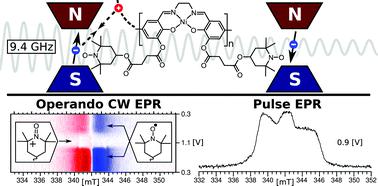当前位置:
X-MOL 学术
›
Energy Environ. Sci.
›
论文详情
Our official English website, www.x-mol.net, welcomes your feedback! (Note: you will need to create a separate account there.)
Spins at work: probing charging and discharging of organic radical batteries by electron paramagnetic resonance spectroscopy
Energy & Environmental Science ( IF 32.5 ) Pub Date : 2022-06-23 , DOI: 10.1039/d2ee01149b Ilia Kulikov 1 , Naitik A. Panjwani 1 , Anatoliy A. Vereshchagin 2 , Domenik Spallek 1 , Daniil A. Lukianov 2 , Elena V. Alekseeva 1, 2 , Oleg V. Levin 2 , Jan Behrends 1
Energy & Environmental Science ( IF 32.5 ) Pub Date : 2022-06-23 , DOI: 10.1039/d2ee01149b Ilia Kulikov 1 , Naitik A. Panjwani 1 , Anatoliy A. Vereshchagin 2 , Domenik Spallek 1 , Daniil A. Lukianov 2 , Elena V. Alekseeva 1, 2 , Oleg V. Levin 2 , Jan Behrends 1
Affiliation

|
Organic radical batteries (ORBs) are a promising class of electrochemical power sources employing organic radicals as redox-active groups. This article reports on the development of a versatile on-substrate electrode setup for spectroelectrochemical Electron Paramagnetic Resonance (EPR) measurements on redox conductive polymers for ORBs. Quantitative in operando EPR experiments performed on electrochemical cells with a di-TEMPO Ni-Salen polymer as active electrode material demonstrate a strong decrease in the number of paramagnetic centers upon oxidizing the film. The distinct EPR signatures of the TEMPO-containing polymer and its fragments in different molecular environments are used to study its degradation upon repeated cycling. A comparison between the number of EPR-active sites and the number of electrochemically active charges, as measured by cyclic voltammetry, provides information on the nature of the degradation process. Low-temperature ex situ pulse EPR measurements on the oxidized polymer film reveal the spectrum of dilute nitroxide species, which may be associated with electrochemically inactive islands. These experiments pave the way for advanced EPR techniques for accurately determining distances between adjacent paramagnetic centers and thus for identifying performance-limiting loss mechanisms, which can eventually help develop strategies for making ORBs powerful contenders on the path towards sustainable electrochemical power sources.
中文翻译:

工作中的自旋:通过电子顺磁共振光谱探测有机自由基电池的充电和放电
有机自由基电池 (ORB) 是一类有前途的电化学电源,采用有机自由基作为氧化还原活性基团。本文报道了一种多功能基板电极装置的开发,用于对用于 ORB 的氧化还原导电聚合物进行光谱电化学电子顺磁共振 (EPR) 测量。操作数中的定量在以 di-TEMPO Ni-Salen 聚合物作为活性电极材料的电化学电池上进行的 EPR 实验表明,氧化薄膜后顺磁中心的数量会大大减少。含 TEMPO 的聚合物及其片段在不同分子环境中的不同 EPR 特征用于研究其在重复循环时的降解。通过循环伏安法测量的 EPR 活性位点数量和电化学活性电荷数量之间的比较提供了有关降解过程性质的信息。低温异地氧化聚合物膜上的脉冲 EPR 测量揭示了稀氮氧化物的光谱,这可能与电化学惰性岛有关。这些实验为先进的 EPR 技术铺平了道路,以准确确定相邻顺磁中心之间的距离,从而确定限制性能的损耗机制,最终有助于制定策略,使 ORB 在通往可持续电化学电源的道路上成为强有力的竞争者。
更新日期:2022-06-23
中文翻译:

工作中的自旋:通过电子顺磁共振光谱探测有机自由基电池的充电和放电
有机自由基电池 (ORB) 是一类有前途的电化学电源,采用有机自由基作为氧化还原活性基团。本文报道了一种多功能基板电极装置的开发,用于对用于 ORB 的氧化还原导电聚合物进行光谱电化学电子顺磁共振 (EPR) 测量。操作数中的定量在以 di-TEMPO Ni-Salen 聚合物作为活性电极材料的电化学电池上进行的 EPR 实验表明,氧化薄膜后顺磁中心的数量会大大减少。含 TEMPO 的聚合物及其片段在不同分子环境中的不同 EPR 特征用于研究其在重复循环时的降解。通过循环伏安法测量的 EPR 活性位点数量和电化学活性电荷数量之间的比较提供了有关降解过程性质的信息。低温异地氧化聚合物膜上的脉冲 EPR 测量揭示了稀氮氧化物的光谱,这可能与电化学惰性岛有关。这些实验为先进的 EPR 技术铺平了道路,以准确确定相邻顺磁中心之间的距离,从而确定限制性能的损耗机制,最终有助于制定策略,使 ORB 在通往可持续电化学电源的道路上成为强有力的竞争者。



























 京公网安备 11010802027423号
京公网安备 11010802027423号